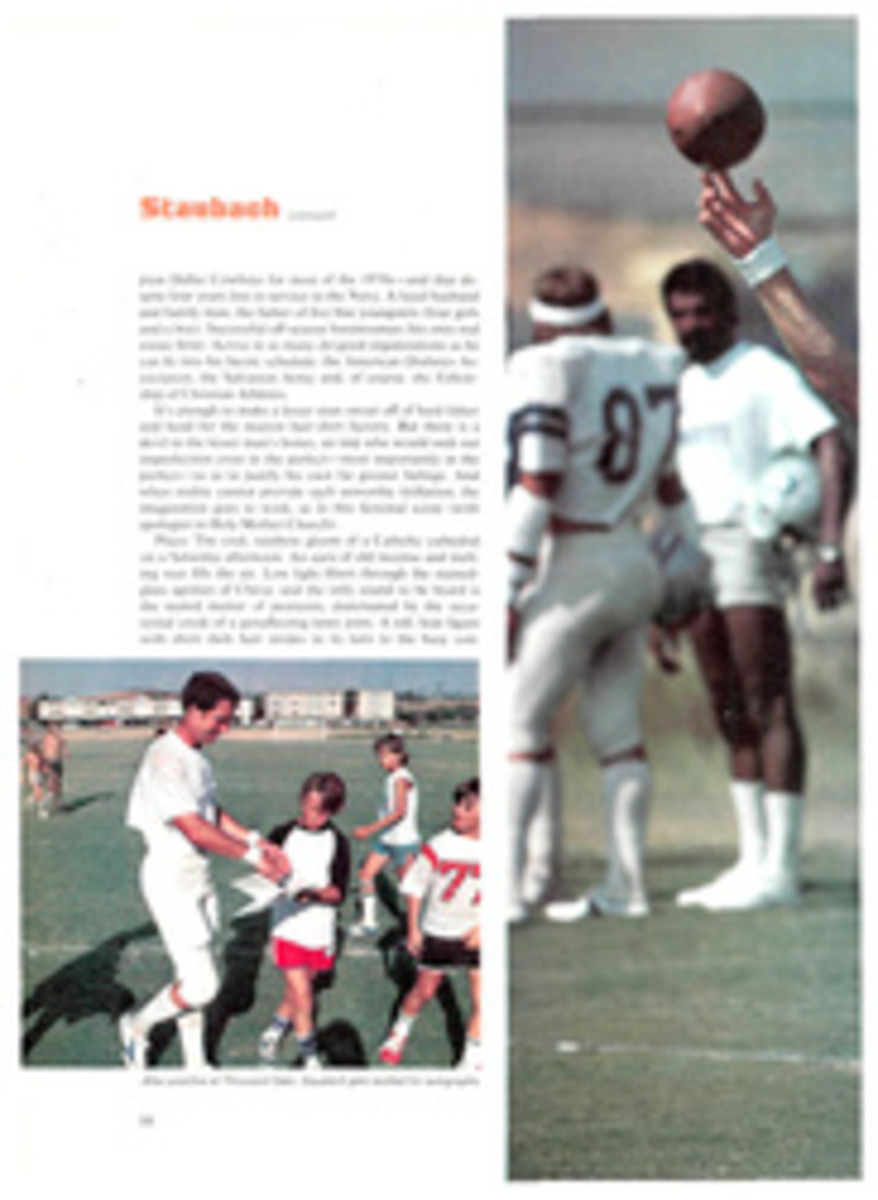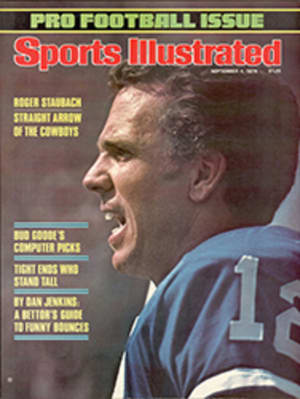
NFC Central
Minnesota keeps hanging on, but winning in this division is getting tougher and the Vikings aren't world-beaters at defending against the run. The defensive line still exhibits the ancient trio of Alan Page, Carl Eller and Jim Marshall. Their strength has always been rushing the passer, but they aren't even particularly good at that anymore. Eller is 36, Marshall 40, and Page, who has weighed as much as 260 but has now dropped to 225, is 33. Opponents are running at the Vikes more and more often, which makes sense—Minnesota allowed the opposition 4.05 yards a carry last year. This year Coach Bud Grant may substitute more freely with three recent first draft picks, Defensive Ends Mark Mullaney and Randy Holloway and Defensive Tackle James (Duck) White.
Minnesota can generally cut off the pass whenever opponents are forced to the air, but Safety Paul Krause, who is only one interception away from Emlen Tunnell's NFL career record of 79, has slowed noticeably.
The Viking offense depends a great deal on the Viking line, which has never quite lived up to its potential. Moreover, the team has been hurt by the loss of Guard Ed White, who forced the trade that sent him to San Diego for Running Back Rickey Young. Despite the skills of Chuck Foreman, who last year gained 1,112 yards, the Vikes' running game is not overpowering.
Quarterback Fran Tarkenton returns for his 18th pro season, and he understands better than anyone in the game how effective dumping the ball off to backs can be. The acquisition of Young, an all-purpose back, gives Tarkenton another handy target. Understandably, with all those pop shots, the Vikes lead the league in percentage of completions. Not that Tarkenton is limited to short passes. In Ahmad Rashad, No. 1 in the NFC with 51 catches last year, and speedy Sammy White (18.5 yards a reception), Tarkenton has as good a pair of deep receivers as any in the NFL.
Chicago has Walter Payton, the league MVP and leading rusher with 1,852 yards. He is showcasing his talents by playing out his option after turning down a contract that called for $1,170,000 over the next three years. New Coach Neill Armstrong is planning to run Payton less and pass to him more so he will be hard-pressed to top last season's performance. Last year the star running back caught 27 passes for 269 yards.
Payton is helped by a superb line that has depth. Lionel Antoine, a former first draft choice, can't win a job at tackle because he has two other No. 1s, Ted Albrecht and Dennis Lick, playing in front of him. In 1977 the Bears were the only team in football to average more than 200 yards a game running. The passing attack, however, is just mediocre. Quarterback Bob Avellini has only one quality receiver, James Scott, who finished second in the NFC with 50 catches.
The Bears are looking for a player to take charge of their defense. Last year, with End Wally Chambers injured, Chicago sagged badly against the run, and the number of sacks fell from 49 to 27. Now Chambers has been traded to Tampa Bay. Hoping to replace his attributes, Chicago traded for San Francisco Defensive End Tommy Hart, who is 33 and had an off year in 1977 followed by knee surgery. Armstrong intends to have the defensive line do a lot of slanting and stunting to compensate for its inability to overpower opponents one-on-one. The new coach will also have the defenses signaled in from the sideline. A defensive strength is the secondary, which allowed only seven touchdown passes last year.
Green Bay's major lesson from 1977 is that it must generate more offense. The Packers scored fewer than 10 points in half their games and got just five touchdowns rushing and six passing. Coach Bart Starr has attempted to spread opposing defenses by drafting a badly needed deep threat, Wide Receiver James Lofton from Stanford. Unfortunately, Starr has lost his top quarterback, Lynn Dickey, who broke a leg in the 10th game last year and has not fully recovered. That leaves the signal calling to second-year man David Whitehurst, an eighth-round draft choice last year from Furman. He has a good arm and mobility but is woefully inexperienced. What's worse, Whitehurst has no running game to fall back on. Chester Marcol, one of the league's best placekickers, does compensate a little for Green Bay's offensive shortcomings.
Starr's critics say he has concentrated too heavily in past drafts on defense. The defense is showing improvement, even though it spends too much time on the field to be really effective. Starr is thinking of occasionally using a 3-4 alignment, because the Packers were below average against the run last year. But Green Bay defenses the pass well and the Packer line, led by End Mike Butler, puts pressure on opposing quarterbacks.
The team's strongest unit is the secondary, which calls itself SWAT and is composed of Cornerbacks Willie Buchanon and Mike McCoy and Safeties Johnnie Gray and Steve Luke. Although they made only 13 interceptions and allowed a higher percentage of completions than any team in football last year, they kept opponents from connecting on long passes, permitting only 10 touchdowns through the air.
Detroit owner William Clay Ford has made a major change in the Lions' organizational philosophy by turning full control of his football operation over to new Coach Monte Clark. In the past, personnel matters were handled by General Manager Russ Thomas, who stood pat with a weak hand for too long. As Clark has pointed out, "This team didn't have a player in the Pro Bowl, so how good can the talent be?"
Fortunately for the Lions, Clark has a reputation for motivating lesser talent. He is also adept at building offensive lines, a real problem area for Detroit, which has given Quarterback Greg Landry the league's worst protection in each of the last two years. And Landry needs a lot of time before the Lions' receivers can get open. Only Luther Blue has speed at wide receiver, and he has trouble catching the football.
Nor has the line opened many holes for a good set of running backs. Dexter Bussey has the quickness to be a big gainer if he can stay healthy. If former No. 1 draft choice Lawrence Gaines, a 240-pounder, recovers from his third knee operation, he could give Detroit power at fullback. Whoever plays, Clark will use the run more than past Lion coaches have.
Detroit's defensive line should be helped by the menacing 6'6", 260-pound rookie defensive end, Al (Bubba) Baker. At Colorado State, Baker—a menace even to himself—branded a "B" onto his biceps with a shaped and heated coat hanger. Detroit plays the run well and puts adequate pressure on the quarterback. However, the secondary, particularly Cornerback James Hunter, too often gets burned deep. First draft choice Luther Bradley, a defensive back from Notre Dame has replaced Lem Barney who was waived. Punter Tom Skladany, acquired from Cleveland, should keep opponents at least a bomb's distance from the goal line.
Tampa Bay has the longest winning streak in the NFC Central—the Bucs' two wins at last season's end, over New Orleans and St. Louis—and that has given Coach John McKay's troops a positive attitude. Now, if the Bucs just had an offense.
Last year Tampa Bay ranked dead last in yards per rush, yards per pass and points. The team was shut out six times. Its offensive line is too much of a disaster area for the Bucs to expect much improvement. Still, there is hope in other quarters. Rookie Quarterback Doug Williams, a first draft choice out of Grambling, has the arm if not the experience to unseat veterans Gary Huff and Mike Boryla. Second draft choice Johnny Davis from Alabama is a piano-playing, gospel-singing, fierce-blocking addition at fullback. He should help last year's top draft choice, Ricky Bell, improve on his 436 yards of rushing.
Defensively, the Bucs are showing signs of maturity. McKay's 3-4 defense is tough to run against. The two Selmons, Defensive End Lee Roy and Linebacker Dewey, and Linebacker David Lewis all appear headed for stardom. Dave Pear is one of pro football's better nose tackles. The front wall could help Tampa Bay's only-average pass defense, however, by applying more pressure. McKay hopes to get a semblance of a pass rush from former All-Pro Wally Chambers, who brought a bad knee from Chicago in return for next year's first draft pick. Some Buc observers fear that trade is an ominous sign of impatience on the part of McKay.
[originallink:10598726:70797]
ILLUSTRATION
PAYTON (TOP) AND FOREMAN ARE A PAIR OF THOROUGHBREDS
FIVE ILLUSTRATIONS
PHOTO

